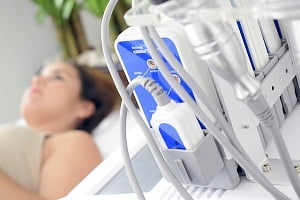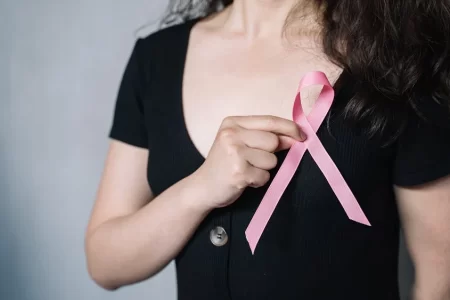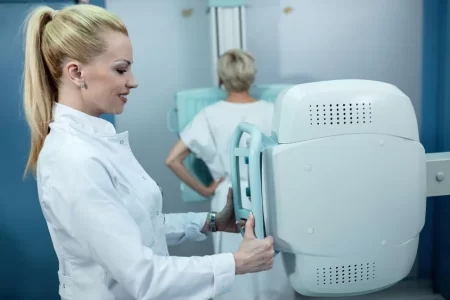Mastectomy Procedure & Its Complications
- Updated on: Jul 5, 2024
- 7 min Read
By
- Published on Oct 3, 2019

What is Mastectomy?
Mastectomy is a surgery that is done to treat breast cancer. In this procedure, the affected breast is removed. Sometimes other tissues near the breast are also removed. Sometimes, a mastectomy is also done to prevent cancer from occurring in women having a high risk for breast cancer.
A breast cancer mastectomy is generally recommended by doctors if:
- the tumor is large
- the tumor involves more than 1 area of your breast
- radiation therapy is not advised for the treatment
- a woman is at a high risk for breast cancer. This includes women with genes linked to breast cancer, such as the BRCA1 or BRCA2 gene.
Types of mastectomy
There are many types of mastectomy as available these days to treat breast cancer. A doctor suggests the type of mastectomy to be done on a particular patient depending on the characteristics of the tumor, the breast, and the patient.
The type of mastectomy done for a woman also depends on the size of the breast.
Simple or total mastectomy
In this procedure, the surgeon removes the entire breast tissue excluding the fascia or lining of the muscle or the muscle tissue under the breast.
Traditional mastectomy
Traditional mastectomy is the most commonly performed procedure even in today’s time. In this procedure, the surgeon removes an ellipse of skin that includes the skin of the areolar complex. If the surgery is not followed by an immediate reconstruction because of any reason, then the end result is a flat chest with a scar about 5 inches in length.
Double mastectomy
If a mastectomy is done on both breasts, it is called a double (or bilateral) mastectomy. It is usually done to reduce the risk of breast cancer.
Partial mastectomy
In this procedure, a circular incision is made around the areola and the breast tissue and the skin of the nipple and areola is removed. In case of a large breast, the surgeon makes a “keyhole” incision (a straight incision in one direction, generally down) to allow removal of the breast tissue. This procedure is also known as skin-sparing, breast-conserving, lumpectomy, quadrantectomy, and segmental mastectomy.
Nipple-sparing
Nipple-sparing surgery involves an incision that is made around the nipple but leaves the areola intact. Usually, an S-shaped incision is made to remove all of the breast tissue.
Total skin-sparing
As the name suggests, in this procedure, the breast tissue is removed leaving all the skin (including the skin of the nipple and areola) behind. The incision can be placed:
- in the outer part of the breast
- in the inframammary fold
- or around the areola
This surgery is only recommended if the tumor is less than 2 centimeters in size and is more than 2 centimeters away from the nipple.
Modified radical mastectomy
This combines a simple or total mastectomy. In this surgery, the skin of the nipple and the areola and most of the lymph nodes in the armpit (axillary nodes) are removed with the help of a 6- to 8-inch incision. Immediate or delayed breast reconstruction can be done after modified radical mastectomy as per the choice of the patient.
Radical mastectomy
Radical mastectomy was very common in the past. However, it is rarely used these days. In this method, the entire breast tissue, all the lymph nodes in the armpit, and the muscles of the chest wall (pectoral muscles) that lie under the affected breast are removed by the surgeon.
More: Early Signs and Symptoms Of Breast Cancer
More: Breast Cancer Diagnosis and Early Detection
What is the procedure of a mastectomy?
Generally, a mastectomy follows this process:
- The patient is asked to remove all clothing and given a gown to wear.
- An IV (intravenous) line may be started in the arm or hand. All medications are given through the IV. These medicines help the patient to relax and put her into a deep sleep during the surgery.
- The patient is made to lie on her back on the operating table.
- The heart rate, blood pressure, breathing, and blood oxygen levels will be checked during the surgery.
- The skin over the surgical site will be cleaned with a sterile solution.
- A cut (incision) will be made in the affected breast. The type of cut made will depend on the type of mastectomy suggested to the patient.
- The cancerous tissue will be gently cut free and removed.
- Lymph nodes may be removed after the breast or breast tissue has been removed.
- If breast reconstruction is to be done immediately after the mastectomy, a plastic surgeon will do the procedure after the mastectomy.
- Breast tissue and other tissues that are removed in mastectomy are sent to the lab for examination.
- One or more drainage tubes may be placed into the affected area.
- The skin will be closed with stitches or adhesive strips.
- A sterile bandage or dressing will be placed over the site.
Mastectomy Complications
Every procedure is associated with some risk. Some possible complications of mastectomy include:
- Short-term breast swelling
- Breast soreness and numbness
- Hardness due to scar tissue that can form at the site of the cut (incision)
- Wound infection or bleeding after the procedure
- Swelling (lymphedema) of the arm, in case of removal of lymph nodes
- Pain in the breast (phantom breast pain). Some medicines may help.
- After mastectomy, a clear fluid (seroma) is often found in the breast. It can be treated by the surgeon with different methods including draining, compression or an injection (harden the space in the breast to help keep fluid from collecting there).
- A scar at the mastectomy site.
- A pulling feeling near or under the arm after the surgery.
- Depression and feelings of loss of sexual identity.
Recovery from mastectomy
Post-mastectomy, the patient is shifted to the recovery room and the doctors and other staff monitor the heart rate, body temperature, and blood pressure. In case of any pain or nauseous, the patient is given medication. The patient generally stays for 3 days in the hospital. If the mastectomy is followed by immediate reconstruction, the stay can be a little longer.
In the hospital, the doctor or the nurse guides the patient on different do’s and don’ts. An exercise routine is recommended to the patient to prevent arm and shoulder stiffness. The surgeon also gives written, illustrated instructions on how to do the exercises so that the patient can have a clear knowledge of the exercises to be done and at what pace.
Before leaving the hospital, the surgeon or nurse guides the patient and her family members about recovering at home. Post-mastectomy care may include the following things:
Taking medication on time
The medicines prescribed by doctors should be taken according to the prescription. Taking medicines on time is very important for on-time recovery.
Caring for the bandage (dressing) over the incision
The surgeon may ask the patient not to remove the bandage. The patient should instead wait until the first follow-up visit so that doctors can remove the bandage.
Caring for a surgical drain
Any drain in the breast area or armpit is removed before leaving the hospital. Sometimes, however, the surgeon may suggest keeping the drain inserted until the first follow-up visit. If the patient is going home with a drain inserted, the fluid from the detachable drain bulb should be emptied a few times a day. Always take instructions from the doctors on caring for the drain.
Stitches and staples
Most surgeons these days use sutures (stitches) that dissolve over time. But sometimes, an end of the suture may poke out of the incision like a whisker. In such cases, the surgeon can easily remove it. Surgical staples are an alternative to stitches which a doctor chooses to close the incision. These are removed during the first office visit after the surgery.
Recognizing signs of infection
The surgeon should explain properly to the patient about recognizing signs of an infection in and around the incision.
Exercising the arm
The exercise routine given by the doctor should be continued at home.
Lymphedema
Lymph node removal increases the risk of arm swelling or infection. Try to avoid trauma or injury to your arms. In case of swelling in arms, immediately contact the doctor.
Wearing a prosthesis or a bra
The patient cannot wear a prosthesis or a bra just after the mastectomy. The doctor will tell you to wait for a specific period of time.
Rest
A proper rest is very necessary for on-time and speedy recovery.
Recovery time after breast surgery (mastectomy)
The recovery time for each surgery is different for different persons. In case of a simple mastectomy, the recovery time is 12 to 15 days if no reconstruction is done after the mastectomy.
Recovery time is longer if breast reconstruction is done and it can take 2 to 3 months to return to full activity.
The recovery time for double mastectomy without reconstruction surgery is 15 to 18 days and with reconstruction surgery is around 3 months.
Breast reconstruction after mastectomy
Breast reconstruction is another surgical option that is done after a mastectomy. In this procedure, the surgeon will recreate the appearance of a woman’s breast or breasts either at the time of mastectomy or at a later time. The tissues taken from another part of a woman’s body, breast implants or a combination of both can be used to reconstruct the breast.
Tissue expansion and implants
In case of an implant reconstruction, a doctor will place a device known as a tissue expander under the chest muscle or breast skin. The patient may need to visit the doctor several times to have the implant filled with saline to expand it. Once the chest skin has healed after the surgery, the surgeon can fit a permanent implant. It can be done about 2 to 6 months after the mastectomy procedure.
Autologous tissue reconstruction
It is also known as “flap” reconstruction. In this procedure, a doctor takes tissue from other parts of a patient’s body which may include the abdomen, back, or buttock. The flap of breast skin that was preserved during the mastectomy is used to reconstruct the breast.
Mastectomy Scars
Scars are the side effects of all kinds of surgeries. Experiencing the scar for the first time can be very difficult and embarrassing. Coping with those scars is a battle a woman fight each day. This may take a lot of time and patience.
Initially, the scar may feel uneven to touch and may feel tight and tender as well. Initially, after the surgery, scars are red but with time they will fade and become less obvious. The specialist team guides the patient about when moisturizing can be done on the scars.
Breast cancer recurrence after mastectomy
The best predictor of cancer recurrence in mastectomy is the presence of cancerous lymph nodes in the underarm area. The more lymph nodes with cancer in the underarm, the higher the risk of recurrence tends to be.
When the lymph nodes do not contain any cancer, the chance of breast cancer recurrence in 5 years is about 6 percent. While with the presence of cancerous lymph nodes, the chance of breast cancer recurrence in 5 years is about 23 percent (if mastectomy without radiation therapy is opted). Radiation therapy can reduce this risk to about 6 percent.











